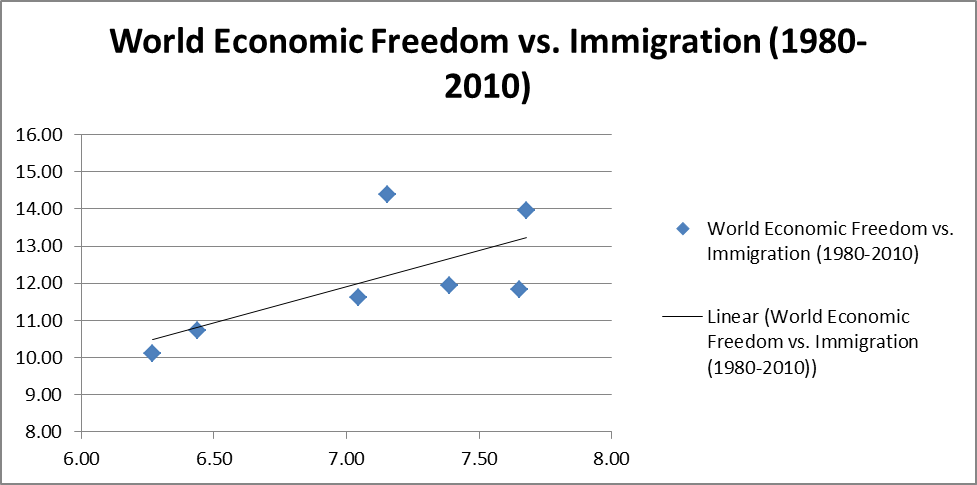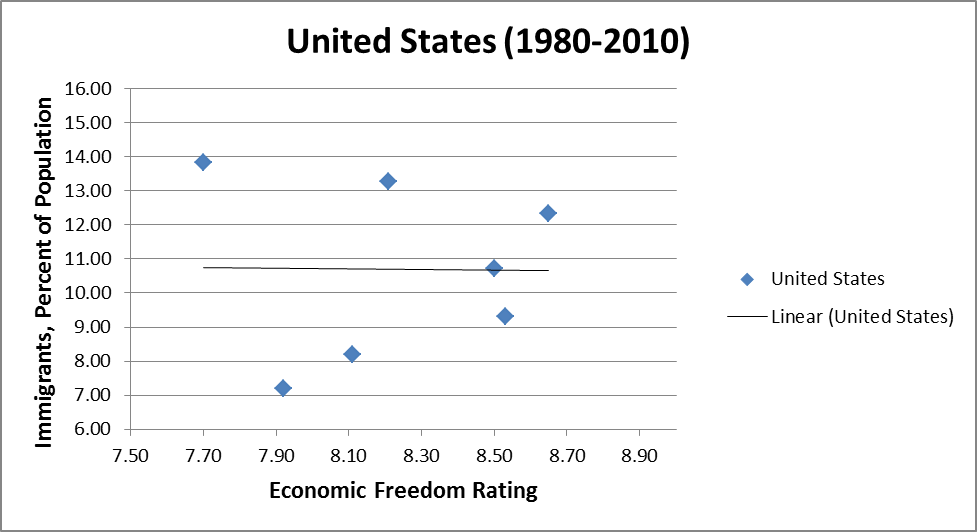Direct Economic Democracy has measured the open borders movement and found it wanting. I couldn’t find any biographical information on the blog other than that the author lives in the UK, so for now the author is just DED to me. Judging by the two posts, DED and I (and probably most advocates of open borders) have substantively different worldviews, but I think there is potentially some common ground. So in addressing our differences I’d like to keep an eye toward our shared aims as well. After all, DED’s tagline is “Everybody matters”, a statement probably every free migrationist would heartily endorse. We advocate open borders in most cases because we think it’s a good way to empower people in poor countries to escape poverty. Likewise, DED is not a committed adversary of open borders, but instead seems to think the world is not yet ready for open borders and demanding free migration too early may evade or worsen the fundamental causes of world poverty:
In principle I share the libertarian ideal of everyone being able to live wherever in the world they fancy. I think the way to go about realising that aim is to first address the issues that create the disparities between rich and poor countries. Once that is (even if only partially) achieved, then the vast bulk of people would no longer have any desire to migrate. A few people would because of personal reasons and for exchange of specialist expertise. However opening borders would then not be opening the floodgates to a torrent of people driven by macroeconomic forces. It is only the prospect of such a torrent that keeps the borders closed now. My total disagreement with the Open Borders campaign is that they advocate opening the borders to a torrent of migration as a first-line response to the disparities between rich and poor countries.
DED begins the (second) post by criticizing free migrationists for describing labor in the rich world as “more productive” than identical labor in the poor world.
To my mind it is grossly insulting to describe that as “less productive” than working in yet another New York restaurant where insufficient custom means the food largely ends up down the sluice. Yet, in terms of how much the workers earn, it is “less productive”. It is all down to the fact that diners in New York have massively more money to spend than diners in Dhaka.
I agree that “productivity” is an unfortunate phrase, especially among non-specialists. It’s important to note that productivity is value-neutral as a technical term. Discussions of productivity differences between rich and poor countries, or similarly between rural and urban environments, have nothing to do with moral character. Because of the potential for connotative misunderstanding though, I prefer not to discuss “worker productivity” but simply wages instead. The pertinent fact is that wages for similar labor and skill sets are higher, sometimes vastly so, in the rich world than in the poor world, and liberalizing migration is the quickest and most straightforward way to eliminate this form of wage discrimination, to the immediate benefit the global poor.
DED suggests this approach is misguided because it fails to address the root causes of global poverty and assumes that such poverty is the result of bad governance in poor countries.
It could be argued that those in the rich world have little capacity to eliminate poverty in foreign countries and so have a greater chance of benefiting the lives of poor people by opening borders to immigration. That argument hinges on the idea that poverty is due to bad governance abroad and that the only answer is for the population to vote with their feet and emigrate. Firstly, I don’t think it is actually true that the rich world is a mere passive observer of poverty abroad. From what I can see, much of the blame for that poverty lies with active policies conducted by the developed world.
[…]
Much of the Open Borders logic seems to stem from the idea that market finance already has an inbuilt characteristic that would always lead towards an optimal solution for the world’s problems if only meddling governments were to stand aside.
I agree that the rich world is not merely a passive observer, but actively enforces policies that inhibit effective development in much of the world. Such policies include the arbitrary borders imposed by Western colonialism, agricultural subsidies cosseting rich farmers and tariffs inflicted on poor farmers, and, I must include, the coercive restrictions on movement known as border controls. I do think that another culprit behind persistent poverty in the world is bad governance. It seems hard to deny that governance has at least some impact in a world that has supplied such natural experiments as the Korean peninsula and East/West Germany. Although too often even the fault of bad governance can be laid at Western feet: the governments of the rich world have exhibited a nasty habit of propping up authoritarian dictators who are friendly to Western interests, or at least the interests of insiders. Then again, it’s important to remember that the “natural state” of humanity is grim poverty and early graves.
My point is not to enumerate the causes of world poverty but only to demonstrate that advocating open borders is consistent with any number of causes of world poverty, including causes DED likely favors. DED rather unfairly implies that advocates of open borders believe that our favored policy is the one true Way to cure what ails the world. But nothing about our advocacy suggests that other complementary policies should not be pursued as well. “Complementary” here is, to some extent, to taste. DED and I will likely disagree on the most effective and most just package of policies to subdue world poverty, but I see no reason in principle why DED, who has no fundamental problem with the freedom to migrate, should not include the opening of borders among their favored policies. Simon Caney’s slate of proposals might be of interest to readers of DED’s ideological persuasion (unfortunately gated). If DED fears the effects of a “torrent” of immigrants, (see here and links therein for a discussion of how likely this is) then the appropriate response is to advocate a gradual opening of borders, rather than defending the status quo.
Even by DED’s own standards of wanting to “address the issues that create the disparities between rich and poor countries” and getting the money to go to where the people are, liberalizing migration is effective. Remittances sent by immigrants to their countries of origin move resources directly into the hands of the poor by magnitudes greater than current official aid from the rich world. Diasporas facilitate investment in the poor world by increasing information flows between agents in rich and poor countries and, importantly, providing economic links augmented by trust and long-term commitment that is absent from far-removed investors.
I have tried to be constructive and non-confrontational in this post because at the end of the day, someone with DED’s concerns and commitments is exactly whom I want to reach (I speak personally here, and not necessarily for my fellow bloggers). But I do want to address some distracting and unnecessary provocations in DED’s posts. Linking to a study relating migration to schizophrenia in a throwaway comment (first post) is insulting to migrants. Hopefully we can all agree that restricting the freedom of movement of people around the world is not an effective way to prevent schizophrenia. And the mention of the Highland Clearances was jarringly irrelevant. No advocate of open borders is proposing a forced relocation of anyone anywhere. It shouldn’t come as a shock that we would decry the Trail of Tears as a blight on American history as well. These were brutally coercive policies that have nothing to do with a liberal migration regime.
It’s reasonable to highlight the abuses that can occur when people migrate to places with minimal standards for human rights protections, as in DED’s link to the story of indentured labourers in Dubai. But I see this as an argument for nations more committed to human rights to open their borders to provide more and better options for the world’s inevitable migrants. This story “underlines a wider phenomenon of migrant workers being in a less assertive position to ensure that they receive a fair level of pay”, something advocates of open borders seek to correct by bringing migration into the formal, regulated economies of democratic societies.
I’ll just close by urging Direct Economic Democracy and their readers to reconsider open borders, or at least reform in that direction, as a policy that could bring substantial benefit to millions of people, even as other systemic maladies of our imperfect world continue to demand solutions.


